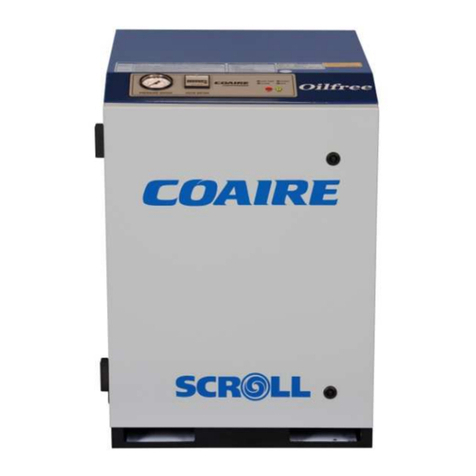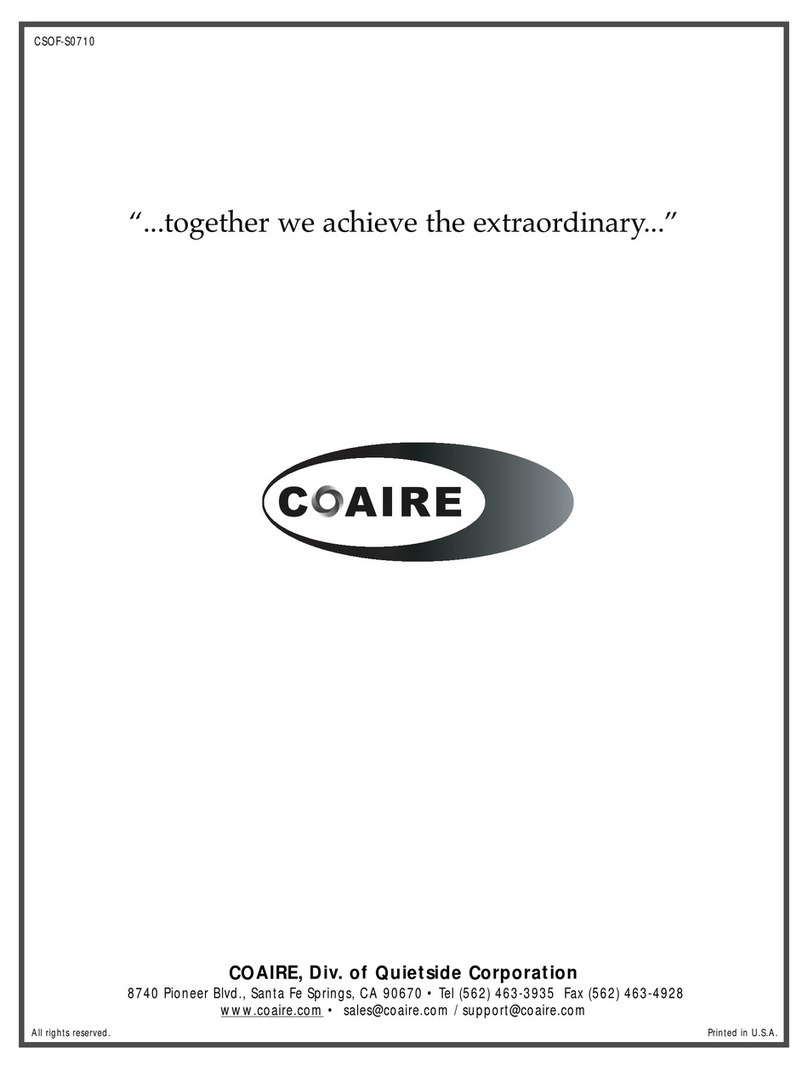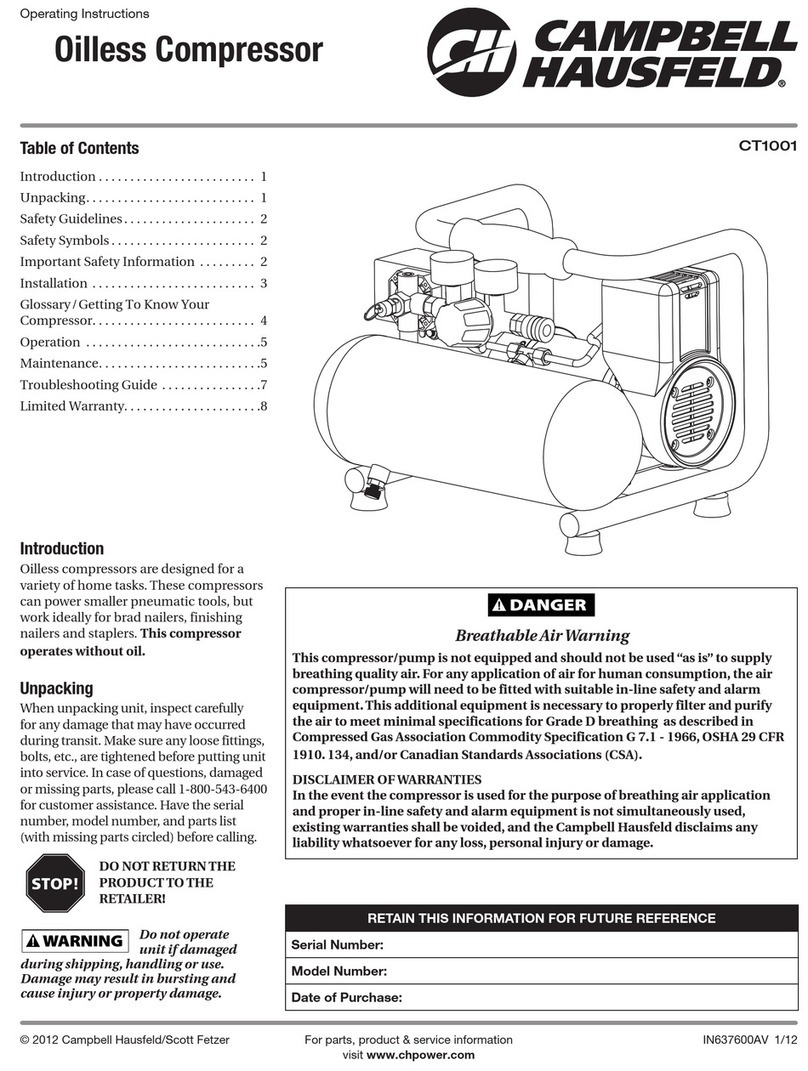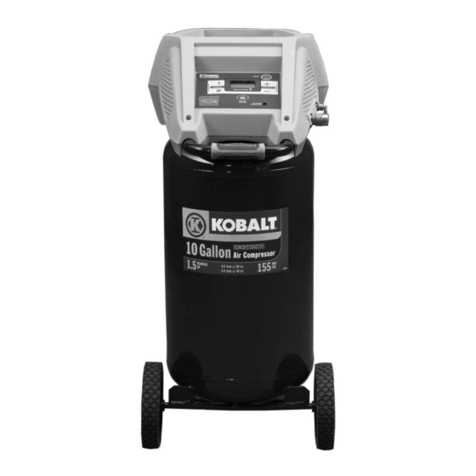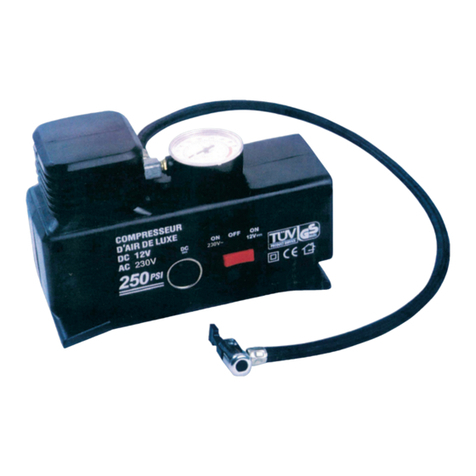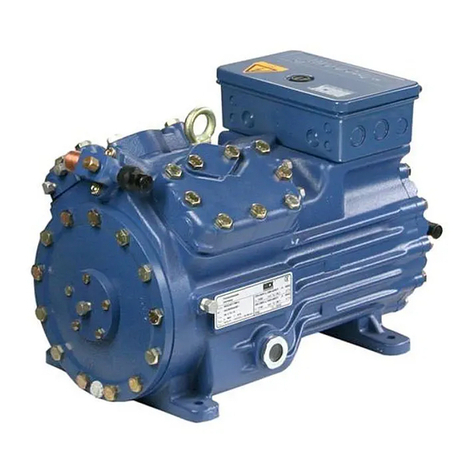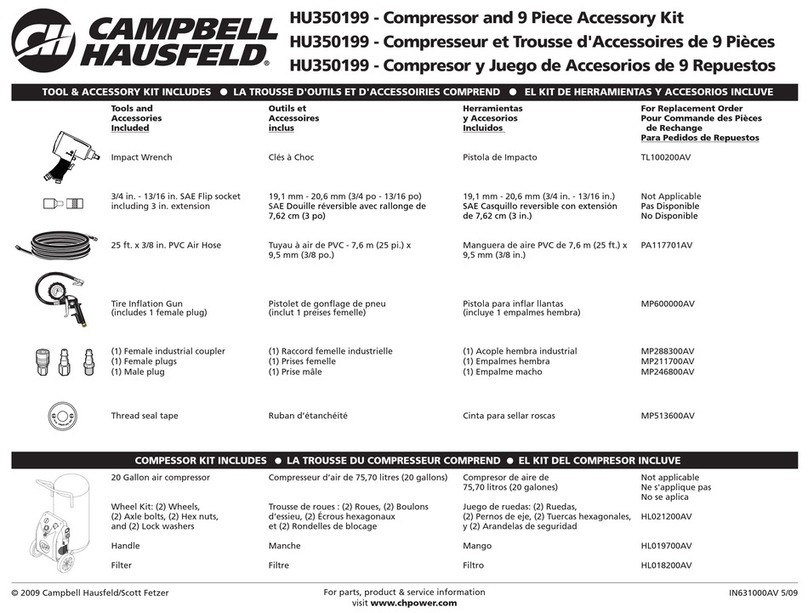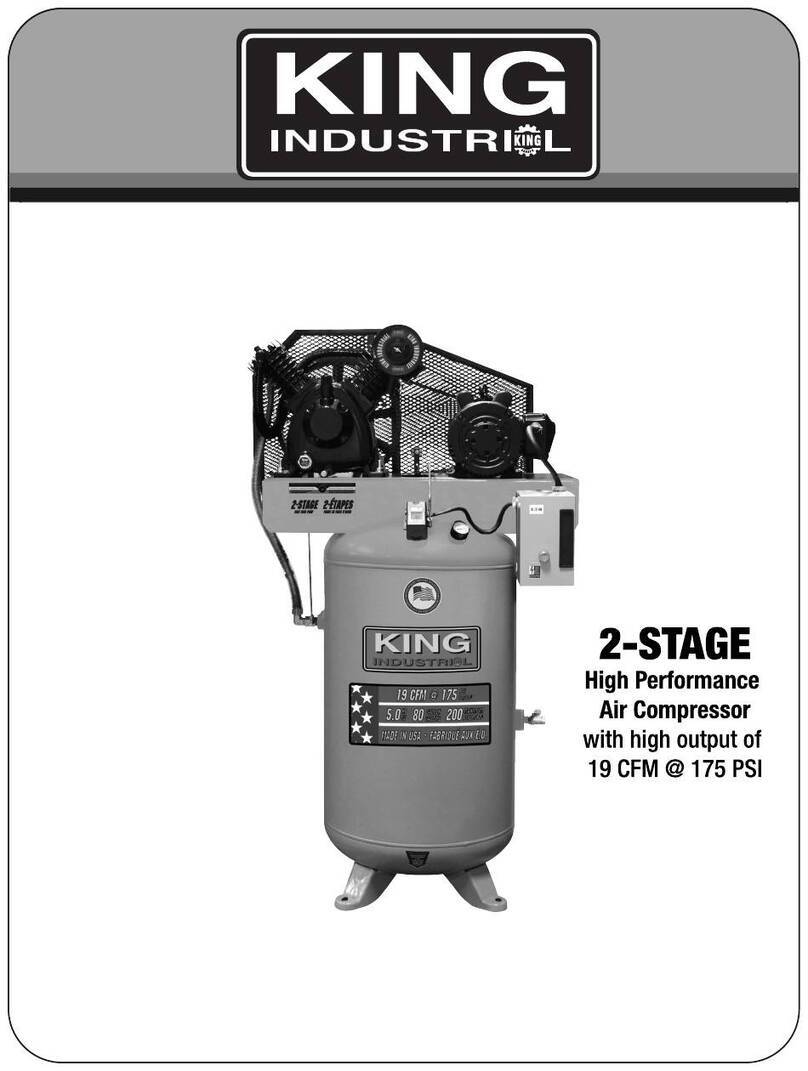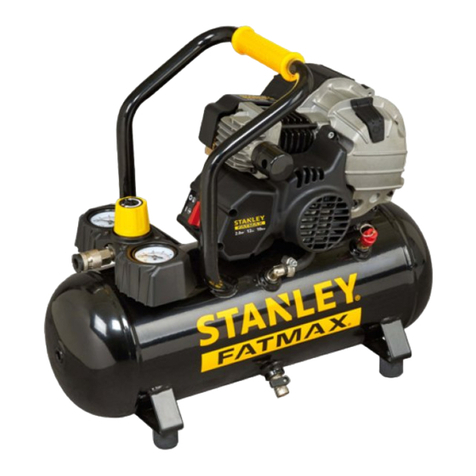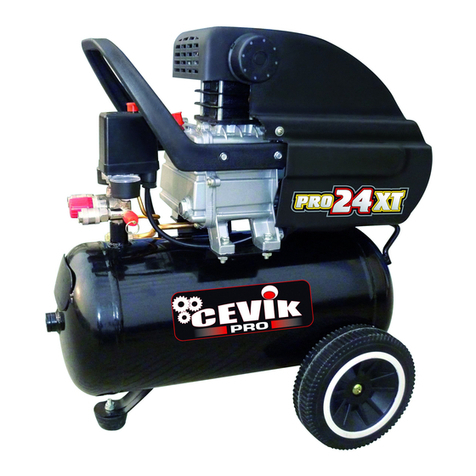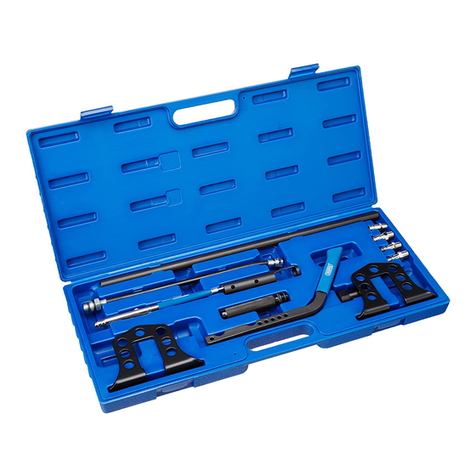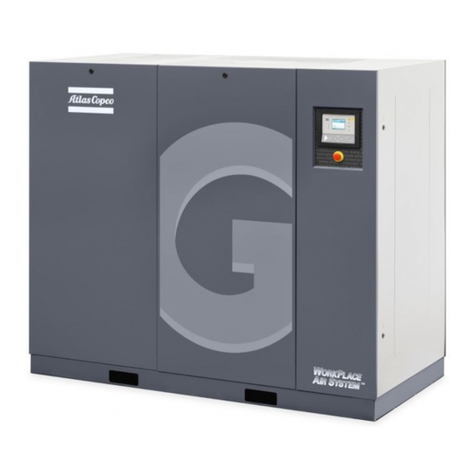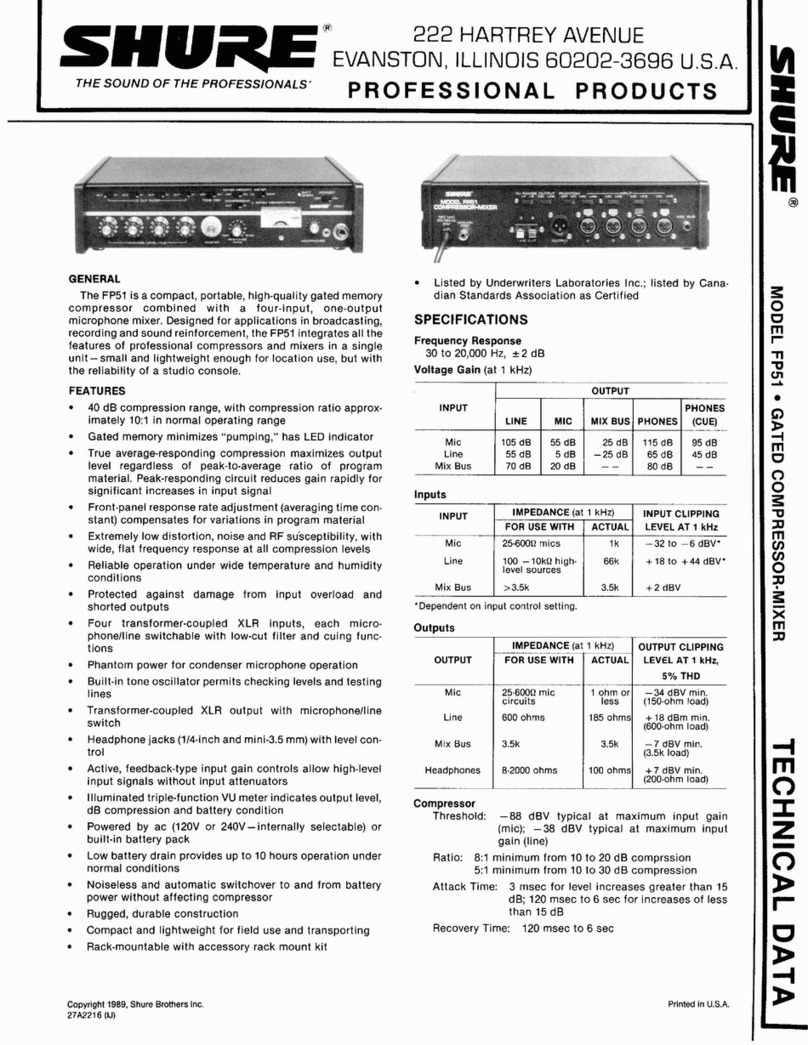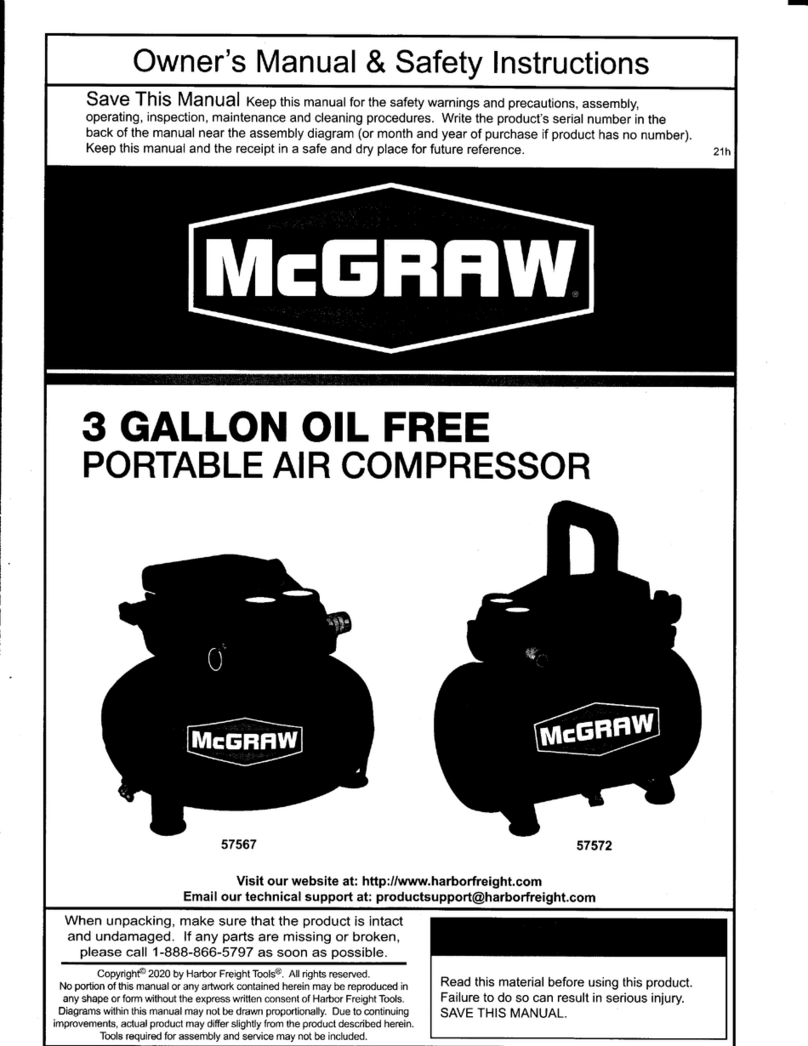Coaire CHSA-7.5M User manual

COAIRE M-Series
EXTROLLER Control System
MAINTENANCE MANUAL AND PARTS LIST
MODEL
CHSA-7.5M CHSA-10M
CHSA-15M CHSA-20M
SERIAL NO. :
MODEL NO. :
MODEL CHSA-15CHSA-20M
COAIRE TECHNOLOGIES, CORPORATION
All rights reserved Printed in USA
ROTARY SCREW AIR COMPRESSORS
For proper and safe use of the compressor, please follow all instructions and safety precautions as identified in
this manual, along with general safety regulations and practices.

SAFETY AND PRECAUTIONS
Before you install the air compressor you should take the time to carefully read all the
instructions contained in this manual. Electricity and compressed air have the potential to cause
severe personal injury or property damage. Before installing, wiring, starting, operating or
making any adjustments, identify the components of the air compressor using this manual as a
guide. The operator should use common sense and good working practices while operating and
maintaining this unit. Follow all procedures and piping accurately. Understand the starting and
stopping sequences. Check the safety devices in accordance with the following procedures
contained in this manual. Maintenance should be done by qualified personnel, accurately with
proper tools. Follow the maintenance schedule as outlined in the manual to ensure problem
free operation after start up.
SAFETY PRECAUTIONS
BEFORE INSTALLING THE COMPRESSOR OR PERFORMING ANY MAINTENANCE READ THIS MANUAL
CAREFULLY.
WARNINGS
COMPRESSED AIR AND ELECTRICITY ARE DANGEROUS. BEFORE DOING ANY WORK ON THIS UNIT, BE SURE THE
ELECTRICAL SUPPLY HAS BEEN SHUT OFF(LOCKED AND TAGGED) AND THE ENTIRE COMPRESSOR SYSTEM HAS
BEEN VENTED OF ALL PRESSURE.
1. Do not remove the cover, loosen or remove any fittings, connections or devices when this unit is operating or in
operation. Hot liquid and air that are contained within this unit under pressure can cause severe injury or death.
2. The compressor has high and dangerous voltage in the motor, the starter and control box. All installations must be in
accordance with recognized electrical procedure. Before working on the electrical system, ensure that the system's
power has been shut off by use of a manual disconnect switch. A circuit breaker or fuse switch must be provided in
the electrical supply line to be connected to the compressor. The preparation work for installation of this unit must
be done in suitable grounds, maintenance clearance and lighting arrestors for all electrical components.
3. Do not operate the compressor at a higher discharge pressure than those specified on the compressor nameplate. If
so an overload will occur. This condition will result in electric motor compressor shutdown.
4. Use only safety solvent for cleaning the compressor and auxiliary equipment.
5. Install a manual shut off valve(isolation type) in the discharge line for service work.
6. Whenever pressure is released through the safety valve during operation, it is due to excessive pressure in the
system. The cause of excessive pressure should be checked and immediately corrected.
7. Before doing any mechanical work on the compressor,
a) Shut down the unit.
b) Electrically isolate the compressor by use of the manual disconnect switch in the power line to the unit. Lock and
tag the switch so that it cannot be operated.
c) Release all compressed air within the system and isolate the unit from any other sources of air.
8. Allowing the unit lubricants to enter into the plant air system must be avoided at all times. Air line separators, which
are properly selected and installed, can reduce any liquid carry-over close to zero.
9. Before starting the compressor, the maintenance instructions should be thoroughly read and understood.
10. After maintenance work is completed, covers must be securely closed.
11. For questions contact your distributor before proceeding.

STATEMENT OF WARRANTY TERMS & CONDITIONS
COAIRE’s screw air compressors are warranted to be free of defects in materials and workmanship under proper use,
installation, and application. This warranty shall be for a period of 15 months from date of shipment from our factory or
other stocking facilities or 12 months from date of installation. Proof of installation date will be required. All air
compressors outside the U.S. and Canada carry a parts only warranty.
ALL FREIGHT DAMAGE CLAIMS ARE NOT THE RESPONSIBILITY OF THE MANUFACTURER AND ARE NOT
COVERED UNDER WARRANTY AS ALL PRODUCTS ARE SHIPPED F.O.B. SHIPPER.
PLEASE DIRECT ALL FREIGHT CLAIMS TO THE SHIPPER IN QUESTION.
MAINTENANCE AND ADJUSTMENTS
ADJUSTMENTS PRESSURE SETTINGS AND MAINTENANCE OF FLOAT AND AUTOMATIC DRAINS AND OIL
COOLER COILS ARE CONSIDERED TO BE ROUTINE MAINTENANCE AND THEREFORE NON-WARRANTABLE
ITEMS AND ARE THE SOLE RESPONSIBILITY OF THE END USER. CONSULT THE INSTALLATION,
OPERATION AND MAINTENANCE MANUAL FOR THE ADJUSTMENT AND MAINTENANCE PROCEDURES.
This warranty does not apply to any unit damaged by accident, modification, misuse, negligence, or misapplication.
Damage to heat exchangers by exposure to ammonia, any other corrosive substance or sub-freezing environment will
be considered misuse.
Any air compressors part or material found defective will be repaired, replaced or refunded, at the sellers option free of
charge, provided that COAIRE is notified within the above stated warranty period. All returns of allegedly defective
equipment must have prior written authorization. Said authorization may be obtained through our air compressor
service department. All air compressors, parts, materials must be returned freight prepaid to the Manufacturer’s
factory within 30 days of return authorization date. Any shipment returned to the factory collect will be refused.
If an item is found to be warrantable, the repaired item or replacement will be returned normal ground freight prepaid
within the continental United States and Canada. Expedited shipment costs are the responsibility of the requestor.
Any replacement part or material is warranted only to the extent of the remaining warranty period of the air compressor
or to the extent as provided by the supplier, whichever is longer.
Identification Plate
The identification plate is located on the side of the air compressor and shows all the primary data of the machine. Upon
installation, fill in the table on the previous page with all the data shown on the identification plate. This data should
always be referred to when calling the manufacturer or distributor.
The removal or alteration of the identification plate will void the warranty rights.
DISCLAIMER
The warranty does not cover any responsibility or liability for direct or indirect damages to persons, or equipment
caused by improper usage or maintenance, and is limited to manufacturing defects only. Refer to COAIRE Warranty
policy manual for travel, mileage and special charge considerations. The warranty will be immediately voided if there
are changes or alterations to the air compressor.
WHO TO CONTACT IF YOU HAVE A WARRANTY CLAIM:
COAIRE Technologies, Corporation Phone (562) 463-3935
Fax (562) 463-4928
All freight damage claims should be filed within 15 working days and should be directed to the carrier.

TABLE OF CONTENTS
Chapter Ⅰ. General information
1-1. Instruction ................................................................................................................................................... 1
1-2. Screw compression process ..................................................................................................................... 1
1-3. Compressed air flow ................................................................................................................................. 2
1-4. Cooling air flow ......................................................................................................................................... 2
1-5. Oil separation ............................................................................................................................................ 2
1-6. Oil flow ...................................................................................................................................................... 2
1-7. Oil scavenge flow ..................................................................................................................................... 2
1-8. Standard Specifications ............................................................................................................................ 3
1-9. Installation and wiring .............................................................................................................................. 4
Chapter Ⅱ. Operating instructions
2-1. Operating panel .......................................................................................................................................... 8
2-2. Initial start-up ............................................................................................................................................ 9
2-3. Daily operation ........................................................................................................................................... 9
2-4. Standard factory settings of control components .................................................................................... 10
2-5. Operation and control sequence ............................................................................................................... 11
Chapter Ⅲ. Functional Description
3-1. Compressor air-end ................................................................................................................................... 12
3-2. Drive motor ................................................................................................................................................. 14
3-3. V-Belt drive ............................................................................................................................................... 14
3-4. Capacity control ......................................................................................................................................... 14
3-5. Lubrication system ..................................................................................................................................... 14
3-6. After cooler/oil cooler ................................................................................................................................ 14
3-7. Oil separator ............................................................................................................................................... 14
3-8. Oil Filter ...................................................................................................................................................... 14
3-9. Thermostatic Valve .................................................................................................................................... 14
3-10. Min. Pressure Valve ................................................................................................................................. 14
3-11. Air Intake Filter ....................................................................................................................................... 14
3-12. Instrument Panel ....................................................................................................................................... 15
3-13. Starter and control box ............................................................................................................................. 15
3-14. Safety device ............................................................................................................................................. 15
Chapter Ⅳ. Scheduled Maintenance
4-1. Standard maintenance schedule .................................................................................................................. 16
4-2. Control of lubrication ................................................................................................................................... 17
Chapter Ⅴ. Trouble shooting
5-1. Trouble symptoms and solutions ................................................................................................................ 19
5-2. Operation record form ................................................................................................................................. 21
Chapter Ⅵ. Corrective maintenance
6-1. Oil filter ........................................................................................................................................................ 22
6-2. Suction filter ............................................................................................................................................... 23
6-3. Oil separator element .................................................................................................................................. 23
6-4. Oil seal ......................................................................................................................................................... 23
6-5. Min. Pressure valve .................................................................................................................................... 24
6-6. Suction control valve .................................................................................................................................. 24
6-7. Cooling fan ................................................................................................................................................... 24
6-8. Oil temperature regulating valve ................................................................................................................ 24
6-9. V-Belt .......................................................................................................................................................... 25
6-10. Pressure transmitter ................................................................................................................................ 26
6-11. Safety valve ............................................................................................................................................... 26
Appendix
A. Compressor Part List ..................................................................................................................................... 27
B. Parts List ....................................................................................................................................................... 30
C. Wiring Diagram .............................................................................................................................................. 38
D. Outline Drawing ............................................................................................................................................... 39

1
CHAPTER I
GENERAL INFORMATION
1-1. INSTRUCTION. COAIRE screw air compressor unit is a complete package type driven by an electric motor.
It is single stage, oil injected, rotary screw type with all components full piped, wired and mounted on a
common base; it is a very self-contained air compressor package.
1-2. SCREW COMPRESSION PROCESS
1-2-1. SUCTION PROCESS. Along with the rotation of the rotor, air is
admitted fully into the void of two rotors through the suction port. The void is
then isolated from the suction port with the casing wall, thereby completing the
suction process.
Fig 1-1. Suction Process
1-2-2. COMPRESSION PROCESS. The air in the void is compressed as the
male rotor lobe meshes between the female rotor lobes and squeezes the air
against discharge cover.
Fig 1-2. Compression Process
1-2-3. OIL INJECTION PROCESS. As pressure builds, oil is injected into the
compression area and onto the bearings, and shaft seal, serving to lubricate,
absorb compression heat and seal the rotors.
Fig 1-3. Oil Injection Process
1-2-4. DISCHARGE PROCESS. Compression continues as the rotor rotates.
When the void comes to the discharge port provided in the discharge chamber,
the compressed air is discharged through the port. While this process is
occurring with one inter-lobe space, the other spaces are following the same
cycle. Therefore, air is compressed continuously.
Fig 1-4. Discharge Process

2
1-3. COMPRESSED AIR FLOW. The panel has an intake duct through which air is drawn into the enclosure.
Airflows through an air intake filter, intake silencer and suction control valve to the air-end suction port. Air
then is compressed by the rotation of the male rotor, and oil is injected into the air-end during compression
process. The injected oil performs various functions, such as, sealing, cooling as well as lubricating. The air/oil
mixture leaves the air-end through the discharge port and flows into the oil separator where the oil is separated
from the compressed air. Compressed air leaves the oil separator, and is supplied to discharge connection of the
unit via minimum pressure valve, after-cooler and liquid separator.
1-4. COOLING AIR FLOW. The air-cooled unit comprises a forced ventilation system with a cooling fan, which
is driven by an electric motor. First, the cooling air removes the heat generated from the main motor, air end,
etc. The cooling air is then forced into the oil and after-cooler by cooling fan. After the heat exchange, the hot
air flows through the ventilation duct and is exhausted from the ventilation louvers in the panel.
1-5. OIL SEPARATION.
Primary separation: Most of the oil is separated from air by the impact at the inner wall of the oil separator and
by the fluid cyclonic effect. After primary separation, the heavy oil falls and is collected in the oil sump at the
bottom of the oil separator.
Secondary separation: The air, which still contains fine oil particles, flows through the oil separator element
where the oil forms into large particles and is collected at the bottom of the element shell. Then, clean air
leaves the oil separator.
1-6. OIL FLOW. The oil, which is collected in the oil sump at the bottom of the oil separator, is circulated
through the lubrication system by the pressure differential existing between the oil separator and the air-end.
The oil temperature control valve is a bypass valve. When the oil is cold, the oil bypasses the oil cooler partly or
completely and is sent to the oil filter. When the oil is hot, 185 ‘F(85’C) or more, the oil flows into the oil cooler
unless by-pass, the compression chamber and lubrication parts of the air-end. Oil injected via the internal oil
hole is provided into the intermesh among male rotor, female rotor and the rotor casing, the shaft seal, suction
side and discharge side bearings.
1-7. OIL SCAVENGE FLOW. After oil is separated from the air and collected in the element shell of the oil
separator, it is scavenged to the compression chamber of the air-end by the internal pressure differential so that
the oil carry-over in the discharged air can be controlled within the allowable limit.

3
M
TS PI
PT
Fig 1-5. Operating flow diagram
1-8. STANDARD SPECIFICATIONS
MODEL
ITEM CHSA-7.5M CHSA-10M CHSA-15M
Motor output Kw(HP) 5.5(7.5) 7.5(10) 11(15)
Discharge pressure psi(g) 110 125 150 110 125 150 110 125 150
Air deliver
y
cfm 29.0 26.5 23.0 38.5 36.0 31.0 57.0 52.0 46.0
Compressor speed RPM 5250 4720 4350 6950 6380 5950 6450 6200 5550
Oil flow rate gpm 4.0 5.3 8.0
Ambient temperature ℉32 115∼℉
Discharge air temperature ℉Inlet air temperature + 27 (MAX)℉
Driving method - V-Belt V-Belt
Voltage V 3Ph(1Ph), 208-230V 3Ph, 208-230/460V
Frequenc
y
Hz 60
Starting method - Direct on Start
Oil sump capacity gal 0.7 0.7 1.1
Noise level dB(A) 68 70 71
Weight lbs 300 310 420
Dimensions(W×D×H) in 17×24.5/8x32.5/8 28.3/4x41.3/8x42.1/8
Air outlet piping size in 3/4” 1”
Air
Cleaner
Solenoid
Valve
Only
15 ~ 30HP
Oil Filter
Oil Cooler
Thermostat
Valve
Oil
Separator
Min.
Pressure
After Cooler
Oil Separator
Tank
Symbol
PT : Pressure Transmitter
TS : Temperature Sensor
PI : Pressure Indicator
M : Motor

4
MODEL
ITEM CHSA-20M CHSA-25M CHSA-30M
Motor output Kw(HP) 15(20) 19(20) 22(30)
Discharge pressure psi(g) 110 125 150 110 125 150 110 125 150
Air deliver
y
cfm 73.4 68.0 64.0 125.3 115.0 108.0
Compressor speed RPM 8280 7900 7500 5700 5380 5160
Oil flow rate gpm 8.5 11.9 11.9
Ambient temperature ℉32 115∼℉
Discharge air temperature ℉Inlet air temperature + 27 (MAX)℉
Driving method - V-Belt V-Belt
Voltage V 3Ph, 208-230/ 460
Frequenc
y
Hz 60
Starting method - Direct on Start
Oil sump capacity gal 1.1 1.3 1.3
Noise level dB(A) 72 73 73
Weight lbs 450 550 630
Dimensions(W×D×H) in 28.3/4x41.3/8x42.1/8 31.1/2x47.1/4x49.7/8
Air outlet piping size in 1” 1”
1-9. INSTALLATION AND WIRING. Upon delivery, carefully check the air compressor unit(s) for damage during
transportation.
1-9-1. HANDLING. When handling by a forklift, make sure that forks completely extend through the width of
the unit. When handling by a shop crane, use the openings provided on common base where slings or steel wire
ropes can be use for lifting.
Fig 1-6. Handling by forklift truck
Fig 1-7. Handling by shop crane
1-9-2. LOCATION. The unit should be installed in a dry, well ventilated area dust-free environment. The unit
should not be installed outdoors. Consideration must be given to the need for clearance around the unit to avoid
the re-circulation of air-end for easy maintenance access.

5
(Unit : Inch)
Fig 1-8. The space clearance example
CAUTION
- Install the unit in a dust-free room of low humidity and on a level concrete floor.
- Never install the unit on timbers or block. High humidity may result in electrical shorts and corrosion.
- Dust particles containing iron or sand may result in poor resistance of the motor and air-end damage.
- A ventilation fan should be provided to keep the ambient temperature 115℉ or lower.
- operation at ambient temperature of higher than 115℉ may cause compressor shutdown or severe
damage to the unit.
HEAT GENERATION & VENTILATION FAN CAPACITY
MODEL
CAPACITY CHSA-7.5M CHSA-10M CHSA-15M CHSA-20M CHSA-25M CHSA-30M
CAPACITY (Btu/h)
AIR VOLUME (cfm) 1165 1235 1900 2120 2330 2540
Note
1. The room ventilation capacity is based on :
(1) Compressor room Temperature rise which is controlled within the 9 .℉
(2) Static pressure of ventilation air should be 0 inchWG.
2. Consult the distributor for more information on ventilation capacity when the air exhaust
duct is installed.
A B C D
CHSA-7.5M 24 42 42 24
CHSA-10M 24 42 42 24
CHSA-15M 24 42 42 24
CHSA-20M 42 42 42 24
CHSA-25M 24 42 42 24
CHSA-30M 24 42 42 24

6
1-9-3. PIPING WORK
CAUTION
- All service piping must be installed so as to exert zero force of movement on the system.
- A drain valve and isolation valve should be mounted near the compressor discharge section.
- Water condensation can affect the operation of pneumatic devices. After-coolers and the addition of
air dryers can eliminate this hazard. Similarly, avoid allowing compressor coolant to enter the plant air
systems. Air line separators properly selected and installed will reduce any liquid carry-over.
- When installed in parallel operation, you must provide an isolation valve and drain trap for each
compressor unit before the common receiver. Screw air compressors should not be installed in air
systems with reciprocating compressors without a means of isolation, such as a common receiver. It
is recommend that both types of compressor units are piped to a common receiver utilizing individual
air lines.
- In case of a lead fluctuation, or a very small volume in pipe from discharge connection of compressor
unit to the end of the piping, the use of air receiver is recommended.
- In case the discharge piping has to be unusually long, you should select the diameter of the piping in
considering the pressure drop in the piping.
- Consult your distributor for proper technical support.
Fig 1-9. Parallel installation Fig 1-10. Installation with reciprocating compressor
1-9-4. ELECTRICITY. This extensive line of Coaire screw air compressors has been designed to provided all
the conveniences of air supply system, especially for the stats of the art manufacturing industries. These units
are composed of compressor, motor, protection devices and control equipment. The applicable voltage range
for each unit is given in the electrical data. The working voltage among the three phases must be balanced
within 2% deviation from each voltage at the compressor terminals. Voltage range limit is to be 90%~110%of
regular voltage described in proportional frequency. Unbalance of voltage measured in motor terminals should
be within 3%in accordance with the following formula :
(V)max - (V)mean
---------------------------- × 100 (%)
(V)mean
where,
(V)max : Maximum voltage among three terminals
(V)mean : Average voltage among three terminals
CAUTION

7
ELECTRICAL WIRING
- Read all related topics in this manual.
- Comply to the National Electric Code(NEC) and any other local codes
- Utilize a qualified, licensed electrical contractor
1-9-5. ELECTRICAL SPECIFICATION
3 Phase Motor
MODEL
AIR-END MOTOR NO FUSE
BREAKER
OVER
CURRENT
RELAY
MAIN CABLE
OUTPUT
[kW/Hp]
INPUT
[kW]
POWER[V]
3ø60Hz
F.L.A.
[A]
L.R.A.[A] POWER
FACTOR
[%]
FRAME
[AF]
TRIP
[A]
TRIP
[A]
POWER
[㎟]
KIV
GROUND
[㎟]
GV
DIRECT Y-DELTA
CHSA-7.5M 5.59/7.5 6.39
208 19.0 70.8 -
94
30 30 22.8 3.5 1.25
230 17.0 64.0 - 30 30 20.4 3.5 1.25
460 8.5 32.0 - 30 15 10.2 2 1.25
CHSA-10M 7.46/10 8.43
208 25.6 74.1 -
91
50 40 30.72 5.5 2
230 23.2 67.0 - 50 40 27.84 5.5 2
460 11.6 38.5 - 30 20 13.92 3.5 1.25
CHSA-15M 11.19/15
13.3
208 38.7 137.1 -
90
60 60 46.44 8 3.5
230 35.0 124.0 - 60 60 42 8 3.5
460 17.5 62.0 - 30 30 21 3.5 1.25
CHSA-20M 14.92/20
16.54
208 52.0 168.0 -
88
100 75 62.4 14 3.5
230 47.0 152.0 - 100 75 56.4 14 3.5
460 23.5 76.0 - 50 40 28.2 5.5 2

8
CHAPTER II
OPERATING INSTRUCTIONS
2-1. INITIAL START-UP. Before starting the unit for the first time, all operators must become familiar with all
parts and assemblies. Only qualified personnel are to start the machine(Contact your distributor).
2-1-1. BEFORE OPERATION
Make sure that :
All installation piping and electrical work has been properly installed and completed.⒜
The main power is disco⒝nnected.
The voltage of the power source is at a regular level.⒞
Tightness of all electrical connections and wirings.⒟
Tightness of all joints, fasteners, covers, plugs and caps are inspected.⒠
Tightness of all grounding connections are inspected.⒡
V⒢-belt tensions are inspected.
The oil level is at the proper point⒣
Isolation stop valve in the discharge air line is completely open.⒤
WARNING
CHECK PROPER ROTATION
There is no the reverse phase relay in the unit. Operator should open the front belt
g
uard and
check proper rotation visually. You can see rotation arrow on the belt guard. Reinstall guard
prior to any further running.
2-1-2. STARTING
Turn on the main disconnection switch.⒜
Power lamp on air compressor instrument panel lights up.
Press start key on operating panel of the unit.⒝
The running lamp on the unit-operating panel lights up.
Check⒞the rotation
While checking proper rotation, you should not run the machine for 5 sec. or more. If you do not, the air-end
will be damaged. Reinstall guard prior to any further operation.
WARNING
REVERSE ROTATION
Upon initial operation, check proper rotation. If reverse rotation, disconnect the main power
and interchange two of three main cables on terminal board installed in the control box.
⒟Check oil level and run the unit for a short period. Oil level may drop as
oil circulates into the system. Add oil if the level during operation should
be below the lower centerline of lower oil level gauge. Press stop button
to stop the motor. After confirming that the discharge pressure gauge
reads 0 psig(approximately 90 seconds after stopping the motor), add oil
as necessary.
⒠Check the unit for any abnormal noise or vibration.
⒡Run the unit at the discharge pressure 57 to 71 psig for approximately
one hour.

9
⒢gradually close the isolation stop valve until the discharge pressure gauge indicates the same pressure as
the oil sump pressure.
WARNING
Do not loosen the oil-filling plug before the internal pressure is vented completely. Make sure
that the oil-filling plug is tightly fastened after oil has been added. Restart the unit. Check the
oil piping for any oil leak, and correct as required.
⒣Check the safety valve ; Pull the attached ring to operate the safety valve, use caution and appropriate
safety equipment.
Check the capacity control system: Gradually close the stop valve at the external air receiver. As discharge
pressure rises, stop closing when the discharge pressure reaches the cutout pressure.
2-1-3. STOPPING
Press ST⒜OP key. Machine is stopped after 30 second, stop control time.
Make sure that the blow⒝-off solenoid valve operates.
The blow-off air sounds for approximately 90 seconds.
Make sure that the discharge pressure gauge reads 0 psig.⒞
2-2. DAILY OPERATION
BEFORE EACH DAY OF OPERATION
⒜Drain the condensation from after-cooler.
Check oil level. Proper oil level is at centerline of upper oil level gage with machine not running.⒝
STARTING
Press START key.
DURING THE OPERATION.
Check oil level gauge.⒜
Make sure that all gauges in compressor instrument panel indicates normal status⒝and followings.
SPECIFICATION UNIT Limit Remarks
Discharge temperature ℉Less Than 203
Ambient Temperature ℉Less Than 115
Indicating Lamps -Run
Voltage Volt Normal Power ±10%
Current Amp Less than Normal Current+15%
Pressure Differential, unit and line PSID Max. 15
STOPPING
Press STOP key.⒜
Make sure that the discharge pressure gauge reads 0 psig.⒝
Operate the toggle switch for oil heater as follows(if op⒞tion is installed) :
For ambient temperature consistently over 50 when the℉unit is idled, place the toggle switch to "OFF"
position. For ambient temperature consistently below 50 when unit is not running, place the toggle℉
switch to "ON" position.
2-3. STANDARD FACTORY SETTINGS OF CONTROL COMPONENTS
SPECIFICATION UNIT STANDARD FACTORY SETTING VALVE
Discharge pressure Psi 110 125 150
Minimum pressure valve Psi 57
Discharge pressure switch Psi 110/90 125/105 150/130
Oil separator element diff. switch Psi 10

10
Oil filter diff. switch Psi 25
Discharge temperature switch ℉220
2-4 Factory Set Values
No. Items Factory set point Adjustable Range
1 Compressor discharge shut down temperature 220 ℉176 ~ 230 ℉
2 Start idling time 5 Sec. 5 ~ 10 Sec.
3 Unloading control time 5 Min. 5 ~ 10 Min.
4 Stop control time 30 Sec. 20 ~ 50 Sec.
5 Drain valve off-time 5 Min. 1 ~ 45 Min.
6 Drain valve on-time 1 sec. 1 ~ 5 Sec.
7 Discharge pressure 110 Psi 80 ~ 190 PSI

11
CHAPTER III
FUNCTIONAL DESCRIPTIONS
3-1. COMPRESSOR AIREND. Oil injected, single stage, rotary screw type that primarily consists of rotors,
housing, and shaft seal along with other component parts.
Features
Precision grind rotors provide close inter■-lobe clearance. This minimizes leakage and increases efficiency.
Long service life and high reliability of bearings achieved by application of 5+7 profile rotors. At the■
discharge end of the compressor, angular contact ball bearings for the male and female rotors are located
to support axial thrust loads and to position the rotor. Cylindrical roller bearings are also located to
support radial loads.
With a differential pressure lubrication system, the compres■sor can dispense with an oil pump, thus
dramatically simplifying the oil supply system.
The wedge construction of the secondary sealing element of the mechanical seal naturally eliminates■
leakage. This seal is highly reliable and excellent performance.
3-1-1. ROTORS. The male rotor has five lobes and the female rotor has seven grooves. This is patented SRM
designed profiles.
Fig 3-2. Pair of rotor
3-1-2. HOUSING. The cylindrical roller bearings support the radial loads, whereas the angular ball bearings
support the axial loads.
3-1-3. SHAFT SEAL. Mechanical seal is fitted on the male rotor shaft to prevent oil leakage.
Fig 3-3. Detail of mechanical seal
3-2. DRIVE MOTOR. IEC or NEMA standard, drip-proof, 3-phase, 2 or 4 pole induction motor.

12
3-3. V-BELT DRIVE. Motor speed is increased by V-belt drive to the male rotor's driving speed.
Fig 3-4. V-Belt drive
3-4. CAPACITY CONTROL. All models provide capacity control, on-line/off-line control. Internal pressure is
vented to atmosphere at partially loaded or unload conditions whereby the motor idles for power saving
features.
3-5. LUBRICATION SYSTEM. The lubrication system consists of oil cooler, oil separator, and controls the oil
temperature within an allowable limit. The oil circulates through the system by differential pressure.
3-6. AFTER COOLER / OIL COOLER. The cooler assembly is consisting in heat exchanger, cooling fan, fan
motor and bracket. After-cooler and oil-cooler are composed of corrugated fin and tube type with aluminum
material. Those fins remove the compression heat efficiently. Cooling fan exhausts the heat-exchanged air
through a ventilation duct to the outside of the enclosure.
3-7. OIL SEPARATOR.Spin-on type Oil separator is located at the air-end, which efficiently separates the oil
from discharged air.
3-8. OIL FILTER.Oil filter element is located at the air-end, which efficiently filtering foreign material from
circulating oil. The oil filter has from 5 to 10 micron paper cartridge, and it should be replaced every 1000 run
hours normally.
3-9. THERMOSTATIC VALVE. This is the oil by-pass valve, Located in the oil cooler outlet pipe in order to
maintain adequate system temperature for efficient compression and protect to making water from compressed
air. The operating temperature is set 160 ℉.
3-10. MINIMUM PRESSURE VALVE. Located in air-end discharge in order to maintain adequate system
pressure for efficient separation of oil, pressure setting is 57 psig. If less than 57 psig, adjust the screw to
maintain pressure on 57 psig or more.
3-11. AIR INTAKE FILTER. The air intake filter is replaceable, dry-type filter with two-stage design. It consists
of an outside element of urethane and inside element of polyester.
3-12. INSTRUMENT PANEL. Consists of start button, stop button, indicating lamps, synoptic display, control
panel and pressure gauge.
3-13 STARTER AND CONTROL BOX. Consists of pre-wired direct starter for model CHSA-7.5M through
CHSA-30M and star-delta starter useable for model CHSA-30M optionally.

13
3-14. SAFETY DEVICE
Shutdown switch for discharge high air temperatures⒜
Differential shutdown switch for oil filter⒝
Differential shutdown switch for oil separator element⒞
⒟Overload for motor
⒠Overload for cooling fan motor
Safety valve⒡

14
CHAPTER IV
SCHEDULED MAINTENANCE
4-1. STANDARD MAINTENANCE SCHEDULE. Maintenance schedule is instructed as below. The intervals are
a guide based on normal operating conditions. If operated in a severe environment, necessary maintenance
service should be performed on a more frequent basis. User should carry out the maintenance work, based on
either the running hours or the calendar time whichever comes first. Please be advised that Items marked with
should be performed by a○user while the other marked with ●should be maintained, by an authorized
distributor.
Part Action
Taken
Maintenance Interval
Remark
Daily
Monthly 6 Monthly Annually 2 yearly 4 yearly
1000 Hrs 3000 Hrs 6K HRS 12K HRS 24K Hrs
Oil Separator
Oil Level Check ○
Condensation Drain ○
Oil
Sampling ○
Replace ○
Oil Tank Clean ○
Level Gauge Clean ○
O-ring, Gasket Replace
○
Monitor Check ○
Air Filter Element Replace
Separator Cartridge Replace ○
Oil Filter Cartridge Replace ○
After Cooler Clean ○
Intake Suction Valve Clean ○
Repair
○
Safety Valve Clean ○
Solenoid Valve Check ○
Min. Pressure Valve Clean ○
Repair
○
V-belt Tension ○
Replace ○
Elec. wire terminal Check ○
Cooling fan Clean ○
Indication of control
panel Check ○
4-2. CONTROL OF LUBRICATION. The control of lubrication is critical. Neglecting it may cause varnish or
Motor
Insulation Check
○
Bearing Replace ●
Grease Refill ○
Air-end
Bearing Replace ●
Oil Seal Replace ●
O-ring, Gasket Replace ●

15
sludge deposits in the system, resulting in severe damage or breakdown of the unit. The major causes of such
deposits are :
Mixing of different types or brands of oil.⒜
Use of unsuitable oil.⒝
Failure to drain the condensation, which will result in oil deterioration.⒞
Failure to change oil within a scheduled maintenance interval.⒟
WARNING
Use of inappropriate oil and/or improper maintenance may result in catastrophic damage to the air
compressor or may result in a oil separator element fire.
CONSULT YOUR DISTRIBUTOR FOR MAINTENANCE SERVICE AND COLUBE 68 COMPRESSOR OIL.
4-2-1. FUNCTIONS OF OIL. Oil is an essential factor in the oil flooded rotary screw compressor. Use COAIRE
COLUBE 68 only, which is developed for pressurized circulation system, containing rust, foam, oxidation and
wear inhibitors along with effective water release characteristics. Oil performs the following functions :
Lubrication : Oil lubricates the bearing and other internal components.⒜
Sealing : Oil seals the clearance between the two rotors and clearance between the rotors and inner wall⒝
of casing. This prevents air leakage above the inter mesh during compression to increase compression
process efficiency.
Cooling : Oil is injected during compression process to remove the heat of compression.⒞
WARNING
Never mix different brands or types of oils each other. Blending of oils may cause a formation of varnish
or sludge deposits in the system. If oils have been carelessly mixed or if a certain brand of oil must be
replaced with another, be sure to flush out the oil system first. Consult your distributor for the
procedures. We highly recommended the use of Genuine COAIRE Screw Compressor Oil
COAIRE-COLUBE 68.
4-2-2. OIL CHANGE.
A practical way is to change the oil at the following intervals:
First oil change: 500 hours after initial start⒜-up.
Second oil change: 1,500 hours after the first oil change.(⒝2,000 hours after the initial start-up)
Third and consequent oil changes: Every⒞3,000 hours after the previous oil change.
⒟Oil life is related to working environment. High operating temperature or dirty ambient conditions will
require more frequent oil changes.
The above intervals are based on normal operating conditions. If condensation is not drained from the unit, the
oil will be deteriorated and required more frequent oil changes.
Proceed as follows:
Run the unit loaded mode long enough to have the oil warm up.⒜
Stop the unit, confirm that the pressure has been released completely, and close the isolation stop⒝valve at
the discharge outlet and disconnect the main electrical.
Place a drain pan unde⒞r the oil drain valve of the unit, and open the valve. Open the plug of oil filling port
on oil separator to speed up draining.
For draining the oil cooler, remove the plug at the drain outlet of the oil cooler to let the oil run down.⒟
Drain the oil as⒠completely as possible. Then, close the drain valve of the oil separator and drain plug of oil
cooler. Return the plug to the drain outlet and tighten.
Fill with new oil through the oil filling port of oil separator. Refer to the specification table for⒡appropriate
oil amount.

16
After securely tightening the plug at the oil filling port, run the unit to make sure there are no oil leaks.⒢
4-2-3 DRAINING CONDENSATION. Moisture contained in intake air can be condensed into water during long
unloading time or when the unit is stopped, and this moisture is accumulates in the separator sump, Since the
water in a compressor system can cause deterioration of oil and internal rusting, do not neglect draining the
condensation at least on a daily basis. Draining should be performed before start-up since oil and condensation
have been sufficiently separated from each other. Open the drain valve at outlet of oil separator sump. Use a
pan to store the condensation being drained. Closely watch the draining condensation, and close the valve.
NOTE
If a compressor operation can be suspended (for example, during lunchtime), it is a wise practice to
drain the condensate once again after the suspension time. Thirty(30) minutes may be enough for
sufficient separation of oil from condensation.
WARNING
Even if the unit is in 24 hour continuous service, it is still recommended to perform a draining
procedure. Normally in such an operation mode, an extra stand-by compressor has to be installed at
the same time to allow for better draining of condensation.
CAUTION
LUBRICANT
Avoid prolonged breathing of vapors. Always use adequate ventilation, contact with eyes should be
avoided. Avoid prolonged periods of skin contact.
If excessive vapors are inhaled, remove person to fresh air area. In the event of contact with eyes,
flush with water and consult a physician if serious irritation persists.
In the event of contact with skin, wash contacted area with soap and water. Wash clothing before
reusing.
Oil is flammable. Use water fog, foam, dry chemical or carbon dioxide to extinguish. Avoid use of
direct stream of water since the oil may float and re-ignite.
Dispose of oil by using an recycling service. Do not dump oil into drain or onto the ground. Do not
place oil or partially filled oil containers in trash. Keep out of sewers and water systems
This manual suits for next models
3
Table of contents
Other Coaire Air Compressor manuals
